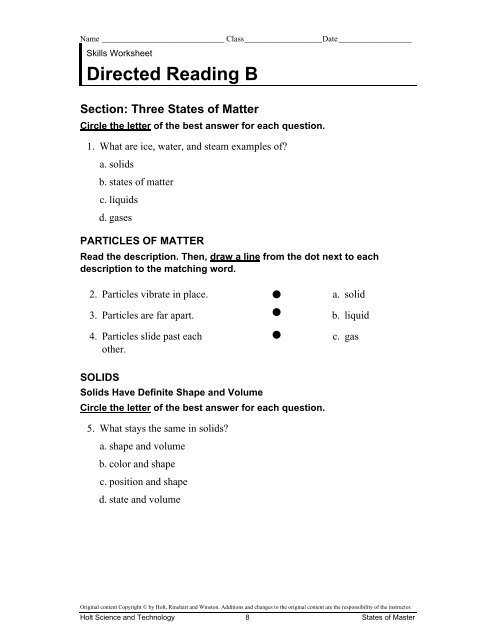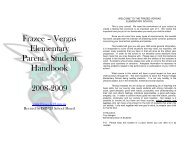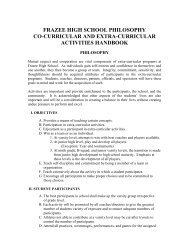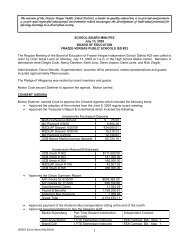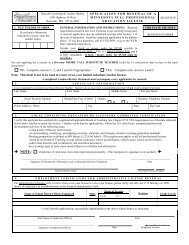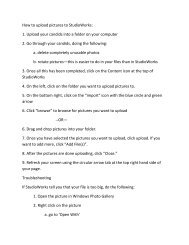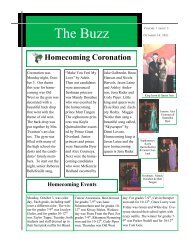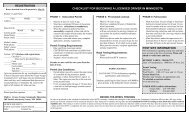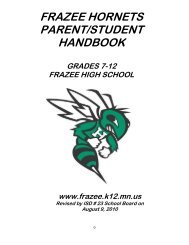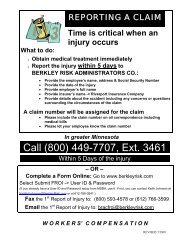Create successful ePaper yourself
Turn your PDF publications into a flip-book with our unique Google optimized e-Paper software.
Name ______________________________ Class___________________Date__________________<br />
Skills Worksheet<br />
<strong>Directed</strong> <strong>Reading</strong> B<br />
Section: Three States of Matter<br />
Circle the letter of the best answer for each question.<br />
1. What are ice, water, and steam examples of?<br />
a. solids<br />
b. states of matter<br />
c. liquids<br />
d. gases<br />
PARTICLES OF MATTER<br />
Read the description. Then, draw a line from the dot next to each<br />
description to the matching word.<br />
2. Particles vibrate in place.<br />
3. Particles are far apart.<br />
4. Particles slide past each<br />
other.<br />
SOLIDS<br />
Solids Have Definite Shape and Volume<br />
Circle the letter of the best answer for each question.<br />
5. What stays the same in solids?<br />
a. shape and volume<br />
b. color and shape<br />
c. position and shape<br />
d. state and volume<br />
Original content Copyright © by Holt, Rinehart and Winston. Additions and changes to the original content are the responsibility of the instructor.<br />
Holt Science and Technology 8 States of Master<br />
•<br />
•<br />
a. solid<br />
b. liquid<br />
c. gas
Name ______________________________ Class___________________Date__________________<br />
<strong>Directed</strong> <strong>Reading</strong> A continued<br />
There Are Two Kinds of Solids<br />
Circle the letter of the best answer for each question.<br />
6. What are two kinds of solids?<br />
a. diamond and ice<br />
b. glass and rubber<br />
c. with and without fixed shape<br />
d. crystalline and amorphous<br />
LIQUIDS<br />
Liquids Change Shape but Not Volume<br />
7. Which statement is true of liquids?<br />
a. They have a fixed shape but not a fixed volume.<br />
b. They have a fixed shape and a fixed volume.<br />
c. They have a fixed volume but not a fixed shape.<br />
d. They do not have a fixed shape or volume.<br />
Liquids Have Unique Characteristics<br />
8. What force acts on particles at the surface of a liquid?<br />
a. viscosity<br />
b. moving particles<br />
c. surface tension<br />
d. states of matter<br />
9. What is a liquid’s resistance to flow called?<br />
a. surface tension<br />
b. viscosity<br />
c. state<br />
d. volume<br />
Original content Copyright © by Holt, Rinehart and Winston. Additions and changes to the original content are the responsibility of the instructor.<br />
Holt Science and Technology 9 States of Master
Name ______________________________ Class___________________Date__________________<br />
<strong>Directed</strong> <strong>Reading</strong> B continued<br />
GASES<br />
Gases Change in Both Shape and Volume<br />
Circle the letter of the best answer for each question.<br />
10. What is the state of matter that has no fixed shape or volume.<br />
a. gas<br />
b. liquid<br />
c. solid<br />
d. state<br />
11. What is true of the particles of a gas?<br />
a. They are very close together.<br />
b. They are always far apart.<br />
c. They slide past each other.<br />
d. They move quickly.<br />
12. Why can a small tank of helium gas fuel 700 balloons?<br />
a. because the empty spaces between the particles can get bigger<br />
b. because helium is a liquid<br />
c. because balloons are solid<br />
d. because the particles of helium in the tank are farther apart than<br />
particles in the balloon<br />
Original content Copyright © by Holt, Rinehart and Winston. Additions and changes to the original content are the responsibility of the instructor.<br />
Holt Science and Technology 10 States of Master


